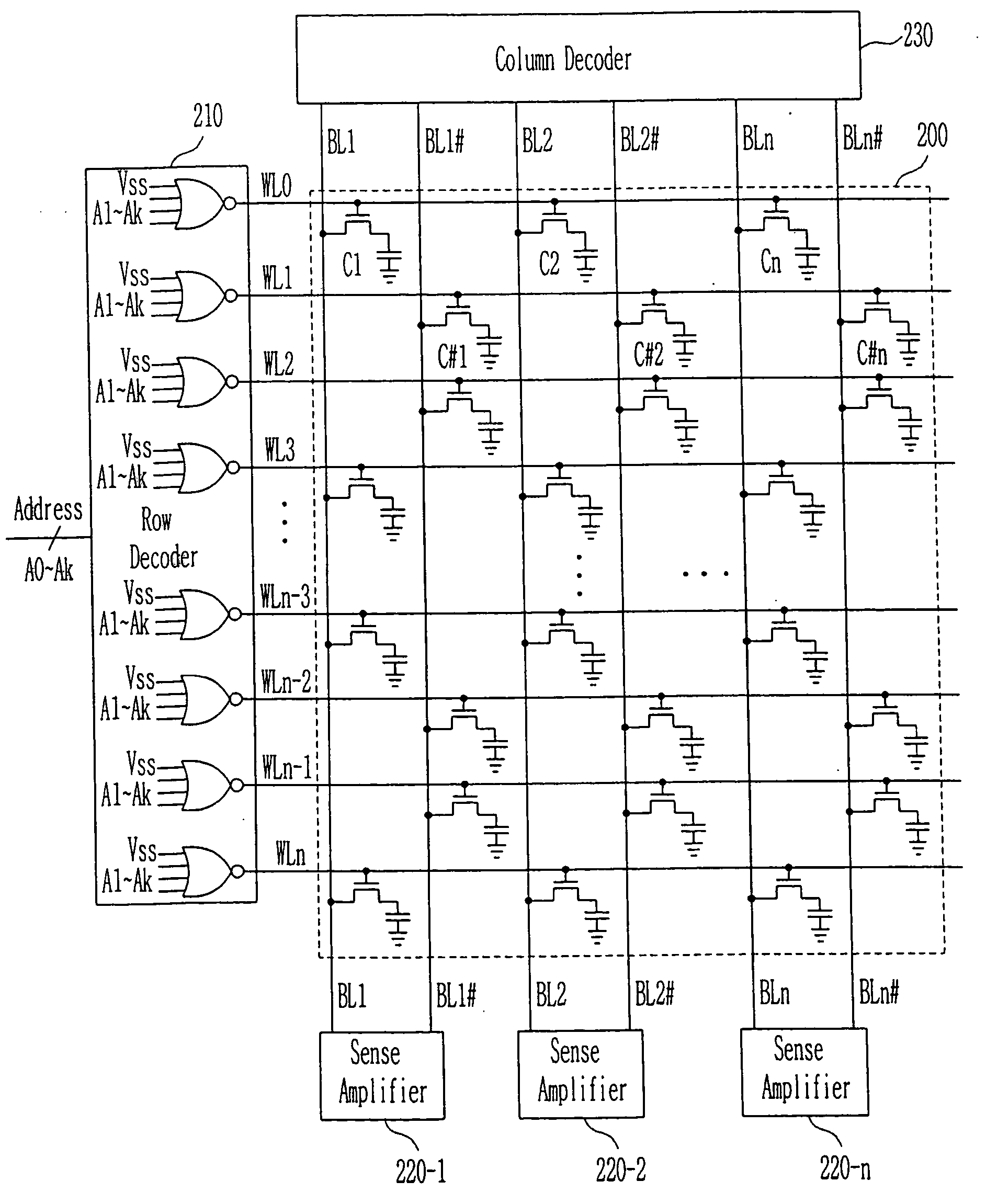Semiconductor memory device
a memory device and semiconductor technology, applied in the field of semiconductor memory devices, can solve the problems of inability to stably keep data of ‘1’, difficulty in keeping data for a long period of time, etc., and achieve the effect of improving the reliability of the device operation, increasing the read margin, and increasing the exactness of the read operation
- Summary
- Abstract
- Description
- Claims
- Application Information
AI Technical Summary
Benefits of technology
Problems solved by technology
Method used
Image
Examples
first embodiment
[0038]FIG. 2 is a circuit diagram for explaining connection relationship and operation of a semiconductor memory device according to the present invention.
[0039] Referring to FIG. 2, in the semiconductor memory device according to the first embodiment of the present invention, a memory cell array 200, sense amplifiers 220-1˜220 -n, a column decoder 230 and peripheral circuits (not shown) are same to the conventional ones. For simplicity, explanation on them will be omitted.
[0040] Meanwhile, in the normal operation or refresh operation, as one of methods for simultaneously selecting two neighboring word lines, the two neighboring word lines may be simultaneously selected by changing an internal circuit of the row decoder 210. An operation of simultaneously selecting the internal circuit of the row decoder 210 and two neighboring word lines will be described by reference to the drawings.
[0041]FIG. 3 illustrates the internal circuit of the row decoder shown in FIG. 2.
[0042] By refer...
second embodiment
[0049]FIG. 4 is a circuit diagram for explaining connection relationship and operation of the semiconductor memory device according to the present invention.
[0050] Referring to FIG. 4, all connection relationship are same to those in the semiconductor memory device described by reference to FIG. 2 but arrangement of the true cells C1˜Cn and C′1˜C′n and the complement cells C#1˜C#n are quite different. In the concrete, in FIG. 2, if two word lines neighboring each other are selected, the memory cell is arranged in one word line such that the word line to which the true cell is connected and the word line to which the complement cell is connected are selected at the same time. As in FIG. 4, however, the memory cell may be arranged such that the two neighboring word lines to which only the true cell or the complement cell is connected may be selected at the same time.
[0051] If the two word lines adjacent to the address signals A0˜Ak are simultaneously enabled by the row decoder 210, t...
third embodiment
[0054]FIG. 5 is a circuit diagram for explaining connection relationship and operation of the semiconductor memory device according to the present invention. FIG. 6 illustrates an internal circuit of the row decoder shown in FIG. 5.
[0055] The third embodiment of FIG. 5 is same to the second embodiment of FIG. 2 except that only the remaining addresses A1˜Ak of the addresses A0˜Ak except for the lowest address A0 are decoded to generate the word line select signal and that the word line select signal generated in the row decoder 210 selects the two word lines at the same time. This will be explained in detail below.
[0056] In the third embodiment, only the addresses A1˜Ak except for the lowest address A0 are decoded to generate a signal for selecting the word line. At this time, if only the remaining addresses A1˜Ak except for the lowest address A0 are decoded, the number of the NOR gate is reduced by half and the size of the row decoder 210 is thus reduced. However, the number of th...
PUM
 Login to View More
Login to View More Abstract
Description
Claims
Application Information
 Login to View More
Login to View More - R&D
- Intellectual Property
- Life Sciences
- Materials
- Tech Scout
- Unparalleled Data Quality
- Higher Quality Content
- 60% Fewer Hallucinations
Browse by: Latest US Patents, China's latest patents, Technical Efficacy Thesaurus, Application Domain, Technology Topic, Popular Technical Reports.
© 2025 PatSnap. All rights reserved.Legal|Privacy policy|Modern Slavery Act Transparency Statement|Sitemap|About US| Contact US: help@patsnap.com



